人机工程__通用设计共50页文档
- 格式:ppt
- 大小:1.91 MB
- 文档页数:50
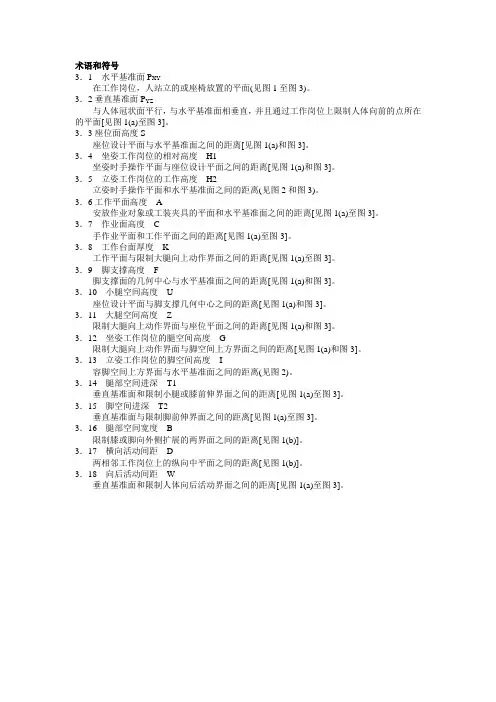
术语和符号3.1 水平基准面P XY在工作岗位,人站立的或座椅放置的平面(见图1至图3)。
3.2垂直基准面P YZ与人体冠状面平行,与水平基准面相垂直,并且通过工作岗位上限制人体向前的点所在的平面[见图1(a)至图3]。
3.3座位面高度S座位设计平面与水平基准面之间的距离[见图1(a)和图3]。
3.4 坐姿工作岗位的相对高度H1坐姿时手操作平面与座位设计平面之间的距离[见图1(a)和图3]。
3.5 立姿工作岗位的工作高度H2立姿时手操作平面和水平基准面之间的距离(见图2和图3)。
3.6工作平面高度 A安放作业对象或工装夹具的平面和水平基准面之间的距离[见图1(a)至图3]。
3.7 作业面高度 C手作业平面和工作平面之间的距离[见图1(a)至图3]。
3.8 工作台面厚度K工作平面与限制大腿向上动作界面之间的距离[见图1(a)至图3]。
3.9 脚支撑高度 F脚支撑面的几何中心与水平基准面之间的距离[见图1(a)和图3]。
3.10 小腿空间高度U座位设计平面与脚支撑几何中心之间的距离[见图1(a)和图3]。
3.11 大腿空间高度Z限制大腿向上动作界面与座位平面之间的距离[见图1(a)和图3]。
3.12 坐姿工作岗位的腿空间高度G限制大腿向上动作界面与脚空间上方界面之间的距离[见图1(a)和图3]。
3.13 立姿工作岗位的脚空间高度I容脚空间上方界面与水平基准面之间的距离(见图2)。
3.14 腿部空间进深T1垂直基准面和限制小腿或膝前伸界面之间的距离[见图1(a)至图3]。
3.15 脚空间进深T2垂直基准面与限制脚前伸界面之间的距离[见图1(a)至图3]。
3.16 腿部空间宽度 B限制膝或脚向外侧扩展的两界面之间的距离[见图1(b)]。
3.17 横向活动间距 D两相邻工作岗位上的纵向中平面之间的距离[见图1(b)]。
3.18 向后活动间距W垂直基准面和限制人体向后活动界面之间的距离[见图1(a)至图3]。
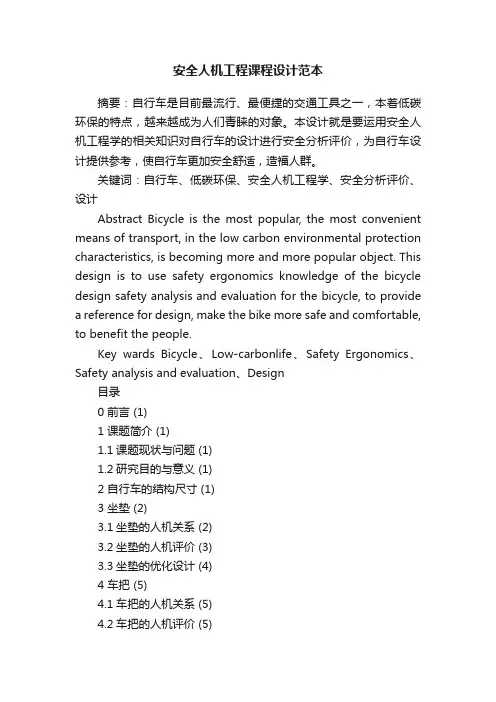
安全人机工程课程设计范本摘要:自行车是目前最流行、最便捷的交通工具之一,本着低碳环保的特点,越来越成为人们青睐的对象。
本设计就是要运用安全人机工程学的相关知识对自行车的设计进行安全分析评价,为自行车设计提供参考,使自行车更加安全舒适,造福人群。
关键词:自行车、低碳环保、安全人机工程学、安全分析评价、设计Abstract Bicycle is the most popular, the most convenient means of transport, in the low carbon environmental protection characteristics, is becoming more and more popular object. This design is to use safety ergonomics knowledge of the bicycle design safety analysis and evaluation for the bicycle, to provide a reference for design, make the bike more safe and comfortable, to benefit the people.Key wards Bicycle、Low-carbonlife、Safety Ergonomics、Safety analysis and evaluation、Design目录0 前言 (1)1 课题简介 (1)1.1课题现状与问题 (1)1.2研究目的与意义 (1)2 自行车的结构尺寸 (1)3 坐垫 (2)3.1坐垫的人机关系 (2)3.2坐垫的人机评价 (3)3.3坐垫的优化设计 (4)4 车把 (5)4.1车把的人机关系 (5)4.2车把的人机评价 (5)4.3车把的优化设计 (5)5 车架 (6)5.1车架的人机关系 (6)5.2车架的人机评价 (6)5.3车架的优化设计 (7)6 脚蹬与曲柄 (7)6.1脚蹬与曲柄的人机关系 (7)6.2脚蹬与曲柄的人机评价 (7)7 结束语 (9)参考文献 (9)0 前言在现代提倡“低碳、绿色、环保”的口号下,自行车在冷淡了一段时期后重新成为了时代的潮流。
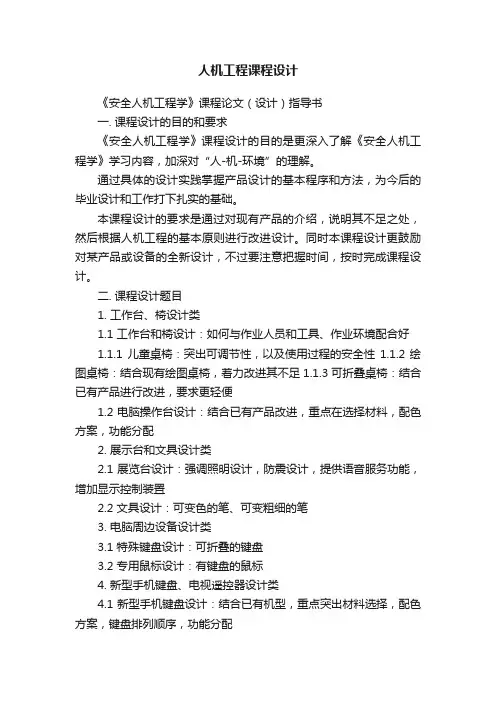
人机工程课程设计《安全人机工程学》课程论文(设计)指导书一. 课程设计的目的和要求《安全人机工程学》课程设计的目的是更深入了解《安全人机工程学》学习内容,加深对“人-机-环境”的理解。
通过具体的设计实践掌握产品设计的基本程序和方法,为今后的毕业设计和工作打下扎实的基础。
本课程设计的要求是通过对现有产品的介绍,说明其不足之处,然后根据人机工程的基本原则进行改进设计。
同时本课程设计更鼓励对某产品或设备的全新设计,不过要注意把握时间,按时完成课程设计。
二. 课程设计题目1. 工作台、椅设计类1.1 工作台和椅设计:如何与作业人员和工具、作业环境配合好1.1.1 儿童桌椅:突出可调节性,以及使用过程的安全性1.1.2 绘图桌椅:结合现有绘图桌椅,着力改进其不足 1.1.3 可折叠桌椅:结合已有产品进行改进,要求更轻便1.2 电脑操作台设计:结合已有产品改进,重点在选择材料,配色方案,功能分配2. 展示台和文具设计类2.1展览台设计:强调照明设计,防震设计,提供语音服务功能,增加显示控制装置2.2 文具设计:可变色的笔、可变粗细的笔3. 电脑周边设备设计类3.1 特殊键盘设计:可折叠的键盘3.2 专用鼠标设计:有键盘的鼠标4. 新型手机键盘、电视遥控器设计类4.1新型手机键盘设计:结合已有机型,重点突出材料选择,配色方案,键盘排列顺序,功能分配4.2 家电遥控器设计:结合已有产品,重点改进材料选择,配色方案,按钮排列顺序,功能分配5. 手推车设计类5.1 婴儿车设计:安全,舒适,易操纵,可调节性强5.2 轮椅设计:安全,舒适,易操纵,可调节性强6. 其他设计类上述未列入的各种设计三. 课程设计的基本程序1. 确定设计任务,提出基本原则和要求;2. 查阅文献资料,标准法规,开展调研;3. 提出设计方案(至少两种方案);4. 修改或确定设计方案(确定方案设计书);5. 功能定义与分配;6. 结构设计、强度设计、人机界面设计(主要内容包括:材料选择,结构设计,强度核算,颜色搭配,键盘按钮或操纵器的排列布置等);7. 作业环境因素分析;8. 作业辅助设计(作业基本要求,人员素质要求,说明书,帮助等);9. 简单的技术经济分析;10. 设计结论、总结和自我评价。

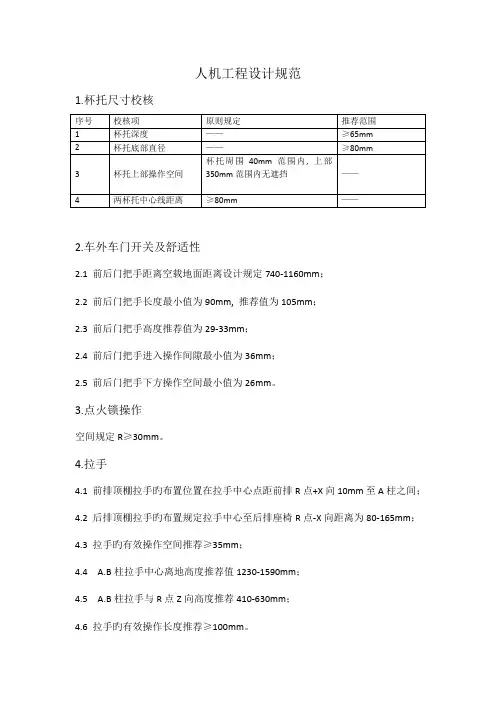
人机工程设计规范1.杯托尺寸校核2.车外车门开关及舒适性2.1 前后门把手距离空载地面距离设计规定740-1160mm;2.2 前后门把手长度最小值为90mm, 推荐值为105mm;2.3 前后门把手高度推荐值为29-33mm;2.4 前后门把手进入操作间隙最小值为36mm;2.5 前后门把手下方操作空间最小值为26mm。
3.点火锁操作空间规定R≥30mm。
4.拉手4.1 前排顶棚拉手旳布置位置在拉手中心点距前排R点+X向10mm至A柱之间;4.2 后排顶棚拉手旳布置规定拉手中心至后排座椅R点-X向距离为80-165mm;4.3 拉手旳有效操作空间推荐≥35mm;4.4 A.B柱拉手中心离地高度推荐值1230-1590mm;4.5 A.B柱拉手与R点Z向高度推荐410-630mm;4.6 拉手旳有效操作长度推荐≥100mm。
5.发动机罩锁人机舒适性序号类别规定(mm)备注1 发动机罩锁手柄后部边缘与发≤25 26-65 66-90 ≥90 动机罩钣金前沿旳距离(A)2 发动机罩弹起后操作发动机罩25 35 45 60锁进入空间(B)3 发动机罩锁手柄后部边缘操作≥25空间(C)6.发动机盖开关及舒适性校核6.1 SAE5%女性手伸及包络(倾斜);6.2 SAE5%女性手伸及包络(不倾斜);6.3 SAE95%男性头部运动包络(倾斜);6.4 SAE95%男性头部运动包络(不倾斜)。
7.发动机盖板翻转起来之后处在6.2和6.3之间, 则满足操作舒适性规定。
8.扶手箱7.1 扶手箱长度及高度旳布置7.1.1 扶手箱旳长度及高度旳一般布置规定如下图所示:注: A SgRP点向前参照值: 100-175mm, 没有上限值;B SgRP点向后参照值: 90-100mm, 没有上限值;H 高度参照值:160-180mm, 最小150mm, 最大190mm。
7.1.2 A.B假如在参照值范围内, 驾驶员手肘不能还是不能碰到扶手箱, 则扶手箱应采用滑移型, 滑移距离最小为50mm。
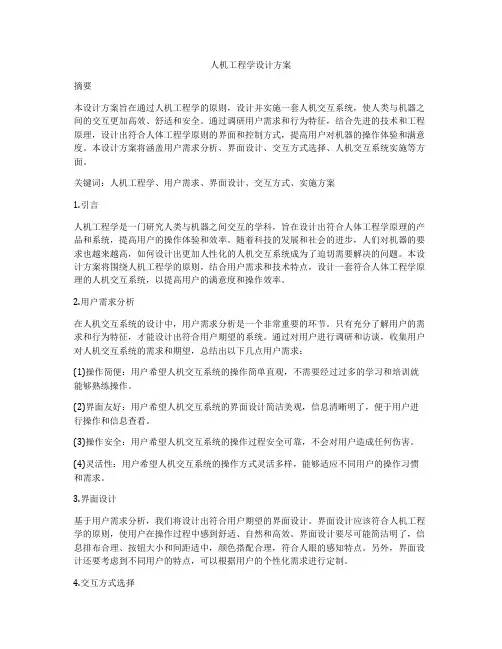
人机工程学设计方案摘要本设计方案旨在通过人机工程学的原则,设计并实施一套人机交互系统,使人类与机器之间的交互更加高效、舒适和安全。
通过调研用户需求和行为特征,结合先进的技术和工程原理,设计出符合人体工程学原则的界面和控制方式,提高用户对机器的操作体验和满意度。
本设计方案将涵盖用户需求分析、界面设计、交互方式选择、人机交互系统实施等方面。
关键词:人机工程学、用户需求、界面设计、交互方式、实施方案1.引言人机工程学是一门研究人类与机器之间交互的学科,旨在设计出符合人体工程学原理的产品和系统,提高用户的操作体验和效率。
随着科技的发展和社会的进步,人们对机器的要求也越来越高,如何设计出更加人性化的人机交互系统成为了迫切需要解决的问题。
本设计方案将围绕人机工程学的原则,结合用户需求和技术特点,设计一套符合人体工程学原理的人机交互系统,以提高用户的满意度和操作效率。
2.用户需求分析在人机交互系统的设计中,用户需求分析是一个非常重要的环节。
只有充分了解用户的需求和行为特征,才能设计出符合用户期望的系统。
通过对用户进行调研和访谈,收集用户对人机交互系统的需求和期望,总结出以下几点用户需求:(1)操作简便:用户希望人机交互系统的操作简单直观,不需要经过过多的学习和培训就能够熟练操作。
(2)界面友好:用户希望人机交互系统的界面设计简洁美观,信息清晰明了,便于用户进行操作和信息查看。
(3)操作安全:用户希望人机交互系统的操作过程安全可靠,不会对用户造成任何伤害。
(4)灵活性:用户希望人机交互系统的操作方式灵活多样,能够适应不同用户的操作习惯和需求。
3.界面设计基于用户需求分析,我们将设计出符合用户期望的界面设计。
界面设计应该符合人机工程学的原则,使用户在操作过程中感到舒适、自然和高效。
界面设计要尽可能简洁明了,信息排布合理、按钮大小和间距适中,颜色搭配合理,符合人眼的感知特点。
另外,界面设计还要考虑到不同用户的特点,可以根据用户的个性化需求进行定制。
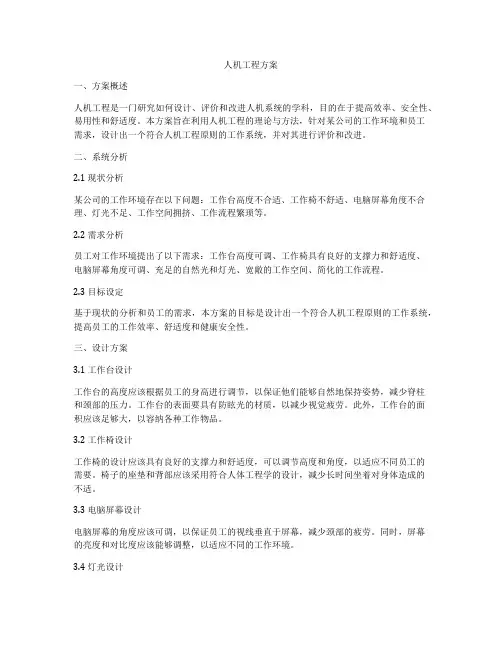
人机工程方案一、方案概述人机工程是一门研究如何设计、评价和改进人机系统的学科,目的在于提高效率、安全性、易用性和舒适度。
本方案旨在利用人机工程的理论与方法,针对某公司的工作环境和员工需求,设计出一个符合人机工程原则的工作系统,并对其进行评价和改进。
二、系统分析2.1 现状分析某公司的工作环境存在以下问题:工作台高度不合适、工作椅不舒适、电脑屏幕角度不合理、灯光不足、工作空间拥挤、工作流程繁琐等。
2.2 需求分析员工对工作环境提出了以下需求:工作台高度可调、工作椅具有良好的支撑力和舒适度、电脑屏幕角度可调、充足的自然光和灯光、宽敞的工作空间、简化的工作流程。
2.3 目标设定基于现状的分析和员工的需求,本方案的目标是设计出一个符合人机工程原则的工作系统,提高员工的工作效率、舒适度和健康安全性。
三、设计方案3.1 工作台设计工作台的高度应该根据员工的身高进行调节,以保证他们能够自然地保持姿势,减少脊柱和颈部的压力。
工作台的表面要具有防眩光的材质,以减少视觉疲劳。
此外,工作台的面积应该足够大,以容纳各种工作物品。
3.2 工作椅设计工作椅的设计应该具有良好的支撑力和舒适度,可以调节高度和角度,以适应不同员工的需要。
椅子的座垫和背部应该采用符合人体工程学的设计,减少长时间坐着对身体造成的不适。
3.3 电脑屏幕设计电脑屏幕的角度应该可调,以保证员工的视线垂直于屏幕,减少颈部的疲劳。
同时,屏幕的亮度和对比度应该能够调整,以适应不同的工作环境。
3.4 灯光设计工作区域应该有充足的自然光和良好的人工照明,以减少眼睛的疲劳。
人工照明的灯具应该采用柔和的光线,避免产生眩光和阴影。
3.5 工作空间设计工作空间应该足够宽敞,以容纳各种工作物品和活动。
工作空间的布局应该合理,减少员工在工作中来回穿梭的次数,提高工作效率。
3.6 工作流程设计工作流程应该简化,减少不必要的动作和步骤。
工作流程的布局应该符合员工的工作习惯,减少员工的体力和脑力负担。

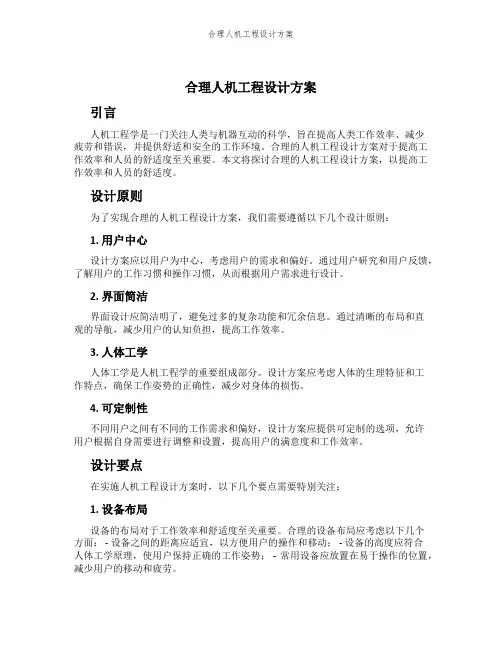
合理人机工程设计方案引言人机工程学是一门关注人类与机器互动的科学,旨在提高人类工作效率、减少疲劳和错误,并提供舒适和安全的工作环境。
合理的人机工程设计方案对于提高工作效率和人员的舒适度至关重要。
本文将探讨合理的人机工程设计方案,以提高工作效率和人员的舒适度。
设计原则为了实现合理的人机工程设计方案,我们需要遵循以下几个设计原则:1. 用户中心设计方案应以用户为中心,考虑用户的需求和偏好。
通过用户研究和用户反馈,了解用户的工作习惯和操作习惯,从而根据用户需求进行设计。
2. 界面简洁界面设计应简洁明了,避免过多的复杂功能和冗余信息。
通过清晰的布局和直观的导航,减少用户的认知负担,提高工作效率。
3. 人体工学人体工学是人机工程学的重要组成部分。
设计方案应考虑人体的生理特征和工作特点,确保工作姿势的正确性,减少对身体的损伤。
4. 可定制性不同用户之间有不同的工作需求和偏好,设计方案应提供可定制的选项,允许用户根据自身需要进行调整和设置,提高用户的满意度和工作效率。
设计要点在实施人机工程设计方案时,以下几个要点需要特别关注:1. 设备布局设备的布局对于工作效率和舒适度至关重要。
合理的设备布局应考虑以下几个方面: - 设备之间的距离应适宜,以方便用户的操作和移动; - 设备的高度应符合人体工学原理,使用户保持正确的工作姿势; - 常用设备应放置在易于操作的位置,减少用户的移动和疲劳。
2. 操作界面设计操作界面设计应简洁、直观且易于操作。
以下几个要点需要特别关注: - 界面布局应合理,各功能模块的位置和顺序应符合用户操作的逻辑; - 控件和按钮的大小和间距应合适,易于点击和操作; - 显示的信息应准确、清晰,避免冗余和重复。
3. 人体工学设计人体工学设计是确保工作环境舒适和避免人体损伤的关键。
以下几个要点需要特别关注: - 坐姿工作时,椅子的高度和腰背的支撑应符合人体工学原理,避免背部疲劳和不适; - 脚部应有足够的支撑,避免双脚悬空或受力不均导致的不适; -键盘和鼠标的高度和角度应适合用户的手臂和手腕,以减少手部疲劳和损伤。
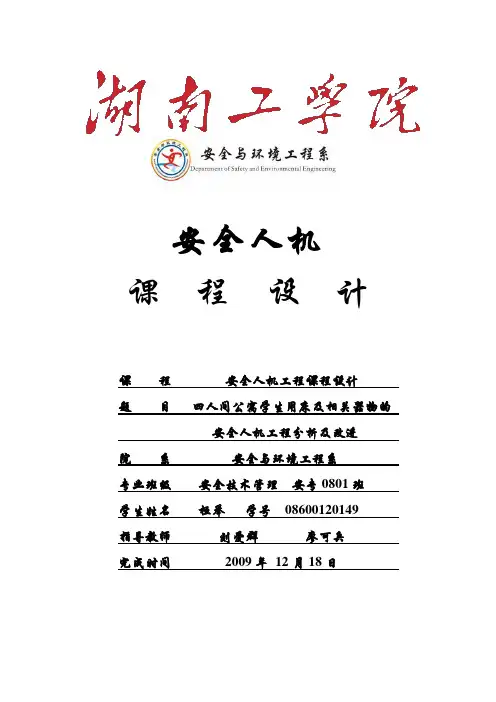
安全人机 课 程 设 计湖 南 工 学 院课 程 安全人机工程课程设计 题 目 四人间公寓学生用床及相关器物的 安全人机工程分析及改进 院 系 安全与环境工程系专业班级 安全技术管理 安专0801班 学生姓名 桓举 学号 *********** 指导教师 刘爱群 廖可兵 完成时间 2009年 12月18日目录摘要: (3)1前言 (3)2四人间公寓学生用床及相关器物的人机关系 (4)2系统中不合理的人机关系及分析 (5)2.1学生与组合柜及相关物品尺寸匹配分析评价 (5)2.1.1人体相关尺寸测量数据 (5)2.1.2组合柜相关实测数据 (8)2.1.2有关物品实测数据 (10)2.1.4人与组合柜及有关物品尺寸匹配现状及分析评价 (11)2.2人与组合柜及相关物品功能(人机关系生理方面)匹配分析评价 (14)2.2人与组合柜及相关物品与环境(人机关系心理方面)匹配分析评价.. 14 4系统中人机关系的改进 (16)5总结 (19)6致谢 (19)参考文献 (20)四人间公寓学生用床及相关器物的安全人机工程分析及改进安全技术管理专业:桓举指导老师:刘爱群廖可兵【摘要】:安全人机工程是从安全的角度和着眼点,研究人与机的关系的一门工程技术。
其立足点在安全上面,以对在活动中过程中的人实行保护为目的,主要阐述人与机应保持什么样的关系,才能保持人的安全。
本次安全人机课程设计是以学生与组合柜及周围环境之间的人际关系为基础,运用相关人体测量数据和组合柜实测数据,从安全、舒适的目标角度分析评价学生与组合柜的人机关系。
以求在本次安全人机工程课程设计中发现存在的隐患问题,并提出相应的改进设计措施,同时不断丰富自己的专业知识,提高专业知识应用能力,问今后的发展奠定基础。
【关键字】人机协调、安全舒适、分析评价、改进设计【Abstract】: Safe man-machine project from safe Angle and human and machine,the relationship of an engineering technology. Its foothold in safety, to the person in the process of practice activities for the purpose of protecting human and machine, what kind of relationship, should maintain the safe to keep people. This course is a safe man-machine students and assorted ark and surrounding environment based on the interpersonal relationship between human body measurements, and assorted ark, measured data from the safe and comfortable target perspective of assorted ark and evaluation of students man-machine relationship. For in this safe man-machine project in the course design of the hidden problems found, and put forward the corresponding improvement measures designed to enrich their knowledge, improve their professional knowledge application ability, ask the future lay a foundation for development.【keywords】:Man-machine coordinated, safe and comfortable, analysis and evaluation, design improvement1前言随着经济的发展,科技的进步,尤其是在21世纪的今天,几乎所有的大中专院校都实现了现代化的学生公寓,给学生创造了优越的学习生活条件,这无疑就是经济发展、科技进步的表现,并令人敢带欣慰。
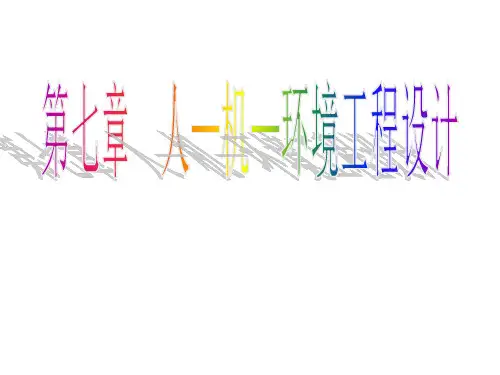
evidence on what works,and equally important what doesn’t work,to reduce deaths and injuries from motor vehicle crashes.In the United States and elsewhere, many lives were lost unnecessarily in crashes during the first50years of motorisation because highway safety advocates promoted ineffective measures while at the same time resisting approaches that later were shown to be effective.It will be a tragedy if the countries relatively new to motorisation repeat these mistakes.Competing interests:None declared.1Eastman JW.Styling vs safety:the American automobile industry and the devel-opment of automotive safety,nham,MD:University Press of America,1984.2Haddon W Jr,Suchman EA,Klein D.Accident research:methods and approaches.New Y ork,NY:Harper and Row Publishers,1964.3Peden MM,Krug E,Mohan D,Hyder A,Norton R,MacKay M,et al.A 5-year WHO strategy for road traffic injury prevention.Geneva:World Health Organization,2001.(Ref No WHO/NMH/VIP/01.03.)4Haddon W Jr.The changing approach to the epidemiology,prevention, and amelioration of trauma:the transition to approaches etiologically rather than descriptively based.Am J Public Health1968;58:1431-8.5Mohan D,Tiwari G.Road safety in less motorized countries—relevance of international vehicle and highway safety standards.Paper C567/008/ 2000.In:Proceedings of the International Conference on V ehicle Safety.London:Institution of Mechanical Engineers,2000:155-66.6Tiwari G.The Indian transportation paradigm.In:W orld resources 1996-97:a guide to the global environment.New Y ork,NY:Oxford Univer-sity Press,1996:90-1.7Vernick JS,Guohua L,Ogaitis S,MacKenzie EJ,Baker SP,Gielen AC.Effects of high school driver education on motor vehicle crashes, violations,and licensure.Am J Prev Med1999;16:40-6.8Mayhew DR,Simpson HM.Effectiveness and role of driver education and training in a graduated licensing system.Ottawa,Ontario:Traffic Injury Research Foundation,1996:30.9Roberts I,Kwan I,Cochrane Injuries Group Driver Education Reviewers.School based driver education for the prevention of traffic crashes.Cochrane Database Syst Rev2001;(3):CD003201.10Williams AF,O’Neill B.On-the-road driving records of licensed race drivers.Accid Anal Prev1974;6:263-70.11Mohan D,Tiwari G.Road safety in low income countries:issues and con-cerns.In:Reflections on the transfer of traffic safety knowledge to motorising nations.Vermount,South Australia:Global Traffic Safety Trust, 1998:27-56.12Retting RA,Williams AF,Preusser DF,Weinstein HB.Classifying urban crashes for countermeasure development.Accid Anal Prev1995;27: 283-94.13The guide to community prevention services.Reducing injuries to motor vehicle occupants.Systematic reviews of evidence,recommendations from the T ask Force on Community Prevention Services,and expert commentary.Am J Prev Med2001;21(4suppl):1-90.14Ross HL.Deterring the drinking driver:legal policy and social control.Lexing-ton,MA:DC Heath,1982(revised1984).15Mohan D.A study of motorized two-wheeler use patterns in Delhi.Indian Highways1983;11:8-16.16W alking in towns and cities:Select Committee on Environment,Transport and Regional Affairs eleventh report.London:Stationery Office,2001.(/pa/cm200001/cmselect/cmenvtra/ 167/16702.htm)17Chawla A,Mohan D,Sharma V,Kajzer J.Safer truck front design for pedestrian impacts.J Crash Prev Injury Control2000;2:33-45.18Trinca GW,Johnston IR,Campbell BJ,Haight FA,Knight PR,Mackay GM,et al.Reducing traffic injury—a global challenge.Melbourne:Royal Aus-tralasian College of Surgeons,198819Elvik R.Area-wide urban traffic calming schemes:a meta-analysis of safety effects.Accid Anal Prev2001;33:327-36.20European Transport Safety Council.Reducing traffic injuries resulting from excess and inappropriate speed.Brussels:European Transport Safety Coun-cil,1995.21Elvik R.A meta-analysis of studies concerning the safety effects of daytime running lights on cars.Accid Anal Prev1996;28:685-94.22Radin UR,Mackay MG,Hills BL.Modelling of conspicuity-related motorcycle accidents in Seremban and Shah Alam,Malaysia.Accid Anal Prev1996;28:325-32.23Shults RA,Elder RW,Sleet DA,Nichols JL,Alao MO,Carande-Kulis VG, et al.Reviews of evidence regarding interventions to reduce alcohol-impaired driving.Am J Prev Med2001;21(4suppl):66-88.24Branas CC,Knudson MM.Helmet laws and motorcycle rider death rates.Accid Anal Prev2001;33:641-8.25Chiu WT,Kuo CY,Hung CC,Chen M.The effect of the T aiwan motorcy-cle helmet use law on head injuries.Am J Public Health2000;90:793-6.Designing road vehicles for pedestrian protection J R Crandall,K S Bhalla,N J MadeleyCollisions between pedestrians and road vehiclespresent a major challenge for public health,traumamedicine,and traffic safety professionals.More than athird of the1.2million people killed and the10millioninjured annually in road traffic crashes worldwide arepedestrians.1Compared with injured vehicle occu-pants,pedestrians sustain more multisystem injuries,with concomitantly higher injury severity scores andmortality.2Although a disproportionately largenumber of these crashes occur in developing and tran-sitional countries,pedestrian casualties also represent ahuge societal cost in industrialised nations.In Britainpedestrian injuries are more than twice as likely to befatal as injuries to vehicle occupants3and result in anaverage cost to society of£57400,nearly twice that ofinjuries to vehicle occupants.4Despite the size of the pedestrian injury problem,research to reduce traffic related injuries has concen-trated almost exclusively on increasing the survivalrates for vehicle occupants.Most attempts made toreduce pedestrian injuries have focused solely onisolation techniques such as pedestrian bridges,publiceducation,and traffic regulations and have not included changes to vehicle design.The lack of effort devoted to vehicle modifications for pedestrian safety has stemmed primarily from a societal view that theinjury caused by a large,rigid vehicle hitting a small,fragile pedestrian cannot be significantly reduced byEducation and debateCenter for AppliedBiomechanics,University ofVirginia,1011Linden Avenue,Charlottesville,Virginia22902USAJ R CrandalldirectorK S Bhallaresearch associateN J Madeleyorthopaedic researchfellowCorrespondence to:J R Crandalljrc2h@BMJ2002;324:1145–8website references.Anatomy of a pedestrian-vehicle crash Most pedestrian-vehicle crashes involve frontal impacts,and the vehicle front structures are responsi-ble for most pedestrian injuries(fig1).In a frontalA pillarsUpper leg form testLeg form testpedestrian safety test requirements.1617The New Car Assessment Programs(NCAP)in many parts of the world have already been performing these tests and making the results available to consumers.18If vehicles are required to comply with the EEVC recommenda-tions,estimated reductions in pedestrian fatalities should exceed20%.3T o obtain further casualty reduc-tions,updates of the test procedures will be required.In particular,the windscreen and windscreen frame are not covered by the current EEVC test method but are responsible for more than15%of all pedestrian injuries8and an even greater share of serious injuries. In addition,improved biofidelity of the impactors and more accurate injury prediction criteria need to be developed through biomechanical studies.1920Despite current testing limitations,however,the EEVC methods have increased societal awareness of vehicle design considerations for pedestrian protection and should,when coupled with collision avoidance systems, reduce injuries in what was once believed to be an intractable problem.Competing interests:None declared.1The World Bank Group.Road /html/fpd/ transport/roads/safety.htm(accessed8Mar2002).2Brainard B.Injury profiles in pedestrian motor vehicle trauma.Ann Emerg Med1986;18:881-3.3Department of the Environment,Transport and the Regions.Transport statistics:Road accidents statistics:Pedestrian casualties in road accidents: Great /facts/accident/pedest/ pedest98.htm(accessed8Mar2002).4Department for Transport,Local Government,and the Regions.Highways economics note No1:2000.Road /roadsafety/ hen2000/index.htm.(accessed8Mar2002).5US Department of Transportation National Highway Traffic Safety Administration.Traffic safety facts2000:A compilation of motor vehicle crash data from the fatality analysis reporting system and the general estimates system.Washington,DC:US Department of Transportation,2000(www-nrd./pdf/nrd-30/NCSA/TSFAnn/TSF2000.pdf).6Otte D,Pohleman T.Analysis and load assessment of secondary impact to adult pedestrians after car collisions on roads.In:Proceedings of2001 International IRCOBI(International Research Council On the Biomechanics of Impact)Conference on the Biomechanics of Impact;2001Oct10-12;Isle of Man, UK.Bron:IRCOBI,2001:143-57.7Lefler DE,Gabler HC.The emerging threat of light truck impacts with pedestrians.Paper No212.In:Proceedings of the17th International Confer-ence on the Enhanced Safety of V ehicles(ESV);2001June4-7;Amsterdam,Hol-land.Washington,DC: Department of Transportation National Highway Traffic Safety Administration,2001(/ departments/nrd-01/esv/esv.html).8Kalliske I,Friesen F.Improvements to pedestrian protection as exempli-fied on a standard-sized car.Report No283.In:Proceedings of the17th International Conference on the Enhanced Safety of V ehicles(ESV);2001June4-7;Amsterdam,Holland.Washington,DC: Department of Transpor-tation National Highway Traffic Safety Administration,2001(/departments/nrd-01/esv/esv.html).9Chidester AB,Isenberg RA.Final report—the pedestrian crash data study.Paper No248.In:Proceedings of the17th International Conference on the Enhanced Safety of V ehicles(ESV);2001June4-7;Amsterdam,Holland.Wash-ington,DC: Department of Transportation National Highway Traf-fic Safety Administration,2001(/departments/ nrd-01/esv/esv.html).10Mizuno K,Kajzer J.Head injuries in vehicle-pedestrian impact.SAE Paper No2000-01-0157.In:Proceedings of the SAE(Society of Automotive Engineers)2000W orld Congress;2000March6-9;Detroit,Michigan.Warren-dale,PA:SAE,2000(/servlets/productDetail?PROD_ TYP=PAPER&PROD_CD=2000-01-0157).11Fredriksson R,Häland Y,Y ang J.Evaluation of a new pedestrian head injury protection system with a sensor in the bumper and lifting of the bonnet’s rear edge.Paper No131.In:Proceedings of the17th International Conference on the Enhanced Safety of V ehicles(ESV);2001June4-7;Amsterdam,Holland.Washington,DC: Department of Transporta-tion National Highway Traffic Safety Administration,2001(www-nrd./departments/nrd-01/esv/esv.html).12Schuster P,Staines B.Determination of bumper styling and engineering parameters to reduce pedestrian leg injuries.SAE Paper No980361.In: Proceeding of SAE(Society of Automotive Engineers)International Congress and Exposition;1998February23-26;Detroit,Michigan.(Ford Motor Co).Warrendale,PA:SAE,1998(/servlets/product Detail?PROD_TYP=PAPER&PROD_CD=980361).13Bunketorp O,Romans B,Hansson T,Aldman B,Thorngren L,Eppingen RH.Experimental study of a compliant bumper system.SAE Paper No 831623.In:Proceedings of the27th Stapp Car Crash Conference.Warrendale, PA:SAE,1983(/servlets/otherProduct?PROD_CD= STAPPCD2000&PROD_TYP=SFTWR).14Y ang JK,Lövsund P,Cavallero C,Bonnoit J.A human-body3d mathematical model for simulation of car-pedestrian impacts.J Crash Prev Injury Control2000;2(2):131-49.15European Enhanced Vehicle-safety Committee.EEVC Working Group 17report:Improved test methods to evaluate pedestrian protection afforded by passenger /publicdocs/ WG17_Improved_test_methods.pdf(accessed8Mar2002).16European Automobile Manufacturers Association(ACEA).Press release.Brussels,11July2001:A step forward into the direction of improved pedestrian protection.www.acea.be/acea/11072001.pdf(accessed9Mar 2002).17European Commission.Press release.Brussels,11July2001:Commission concludes talks with car industry and consults Council and Parliament on industry’s self-commitment to enhance pedestrian protection.http:// europa.eu.int/rapid/start/cgi/guesten.ksh?p_action.gettxt=gt&doc=IP/ 01/986|0|RAPID&lg=EN(accessed9Mar2002).18European New Car Assessment Programme(Euro NCAP).(accessed8Mar2002).19Wittek A,Konosu A,Matsui Y,Ishikawa H,Sasaki A,Shams T,et al.A new legform impactor for evaluation of car aggressiveness in car-pedestrian accidents.Paper No184.In:Proceedings of the17th International Conference on the Enhanced Safety of V ehicles(ESV);2001June4-7;Amsterdam,Holland.Washington,DC: Department of Transportation National Highway Traffic Safety Administration,2001(/ departments/nrd-01/esv/esv.html).20Konosu A,Ishikawa H,T anahashi M.Reconsideration of injury criteria for pedestrian subsystem legform test—problems of rigid legform impac-tor.Paper No01-S8-O-263.In:Proceedings of the17th International Confer-ence on the Enhanced Safety of V ehicles(ESV);2001June4-7;Amsterdam, Holland.Washington,DC: Department of Transportation National Highway Traffic Safety Administration,2001(/ departments/nrd-01/esv/esv.html).Education and debate。